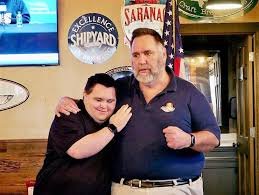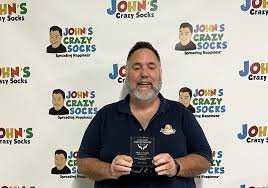The Bumpy Road to Treating a Rare Eye Condition (Keratoconus) in My Son with Down Syndrome
John Cronin and his father, Mark.
By Mark X. Cronin
John Cronin, a young man with Down syndrome, has an eye condition called keratoconus. His path to receiving a diagnosis and the right treatment serves as an example of the challenges in treating people with a differing ability. I know his story because John is my youngest son, so let me share with you his journey and some of the lessons we’ve learned.
What is Keratoconus?
Keratoconus is a progressive eye condition characterized by thinning and bulging of the cornea, causing it to take on a cone-like shape. Left untreated or treated incorrectly, it can lead to blindness.
It is a relatively rare condition with estimates of its prevalence ranging from 0.04% to 0.15%. Keratoconus typically strikes patients in their late teens or early twenties. People with Down syndrome, like John, are more likely to develop the condition. The National Keratoconus Foundation estimates that between 5-30% of children with Down syndrome have keratoconus.
Recognizing that John Had Difficulty Seeing
We do not know when John started developing keratoconus. John did not complain about problems with his eyesight. That is not to say that he did not have problems seeing. There are two issues here.
“Keratoconus is a progressive eye condition characterized by thinning and bulging of the cornea, causing it to take on a cone-like shape. Left untreated or treated incorrectly, it can lead to blindness…People with Down syndrome are more likely to develop the condition.”
If we have lived with a condition all our lives, we often take that to be normal. Many years ago, I took my two older boys on a cross-country road trip with a friend and his son. My eldest son Patrick was getting ready to enter the sixth grade. We played many road trip games identifying license plates, animals, and road signs. Only in playing those games did we realize that Patrick struggled to see things that others saw easily. Upon our return home, we had his eyes examined, and it turned out that Patrick was nearsighted. Once he started wearing glasses and then contacts, he said, "I thought everybody saw a blurry world. I didn't realize this is how things were supposed to look."
The second challenge is particular to people with different abilities. They are always adapting. They are always finding a way to make do. Therefore, they are less likely to identify a problem because they are working around it.
Identifying John’s Eyesight Problem
During checkups with his pediatrician, John would receive a cursory eye exam. Yet at no time did that raise any concerns. Why not? John may have been good at fooling the test. And the staff giving the test were focused on getting it done and moving on to the next box on their checklist. Such is modern medicine. It can be hard for medical staff to take the time to listen and probe and consider the data coming from a person with different abilities.
We were fortunate because an astute teacher recognized that John struggled to see writing on the blackboard and certain signs and images. At the same time, we grew concerned at home as we noticed John squinting to focus his eyes.
We took John to see an ophthalmologist. That first doctor said John might have an astigmatism with his eyes. His suggestion: have John sit in the front of the classroom to see the blackboard better, and he gave John some glasses with mild corrective lenses.
The problem persisted. Again, John did not complain. He was busy showing he could wear the glasses and could do everything asked of him. And again, it took the combination of John's teachers who knew him and paid such careful attention and our observations to decide we needed a second opinion.
We took John to see a second ophthalmologist. This doctor diagnosed his keratoconus. That doctor gave John a prescription for thick, hard contact lenses that might help with his vision and would hopefully slow the degeneration of his eyes.
We sought out an optometrist who had worked with patients who had Down syndrome. Robert Greziak, a.k.a. Dr. Z., spent hours with John fitting him for contacts and teaching him how to put in the contact lenses. John spent months learning how to put those contact lenses in his eyes. Dr. Z demonstrated tremendous patience and empathy, seeking a creative solution. What he settled on was a contraption that looks like a golf tee and has a light shining through it. John put the lens on top of the tee and lowers his head onto the lens. It works for him.
A Problem Remained
The contacts could slow down, but not halt the degeneration. John needed a longer-term solution. The second ophthalmologist declared that John would not be a good candidate for the additional interventions, including corneal cross-linking, and would certainly not be receptive to a cornea transplant because of his Down syndrome.
This left John in a terrible situation. He is dutiful about wearing his contact lenses and taking care of them. He is an excellent patient. However, the contact lenses are not a cure or solution for keratoconus. We were left hoping that his eyes would not degenerate.
Hope on the Horizon
My wife read everything she could find and believed that John’s Down syndrome would not limit his treatment options. We kept looking for a better solution. I attended a webinar on eyesight challenges for people with down syndrome that was organized by the National Down Syndrome Society and found some hope. One of the presenters, Dr. Ann Ostrovsky, not only had an expertise in treating keratoconus, she had experience working with patients with Down syndrome. And she worked at NYU-Langone Medical Center in New York City, and since we lived on Long Island, we could see her.
Dr. Ostrovsky gave John the most thorough eye exam he had ever received. She confirmed the diagnosis of keratoconus. She was angry that his previous doctor had said John was not a candidate for certain interventions. She could see his responsiveness, competence, and level of responsibility.
She wanted to apply the corneal cross-linking (CXL), a minimally invasive procedure designed to strengthen the cornea and halt the progression of keratoconus. It involves peeling back the lens and injecting B12 directly into the cornea. It strengthens the eye and halts the degeneration for up to five years.
Unfortunately, the condition had degenerated John's eyes so that she could only apply this treatment to his right eye because the cornea in his left eye had become too thin. The missed diagnosis and erroneous treatment had cost John.
John underwent a successful cross-linking treatment in Dr. Ostrovsky's office. We scheduled regular follow-up appointments to track the status of his eyes. The combination of that treatment and the contact lenses has slowed the degeneration. If it does worsen, John will need to undergo a cornea transplant. That is a serious procedure that requires a long recovery time. It will be challenging, but it will also prevent John from becoming blind.
There is Still a Bumpy Road
John remains optimistic, and we continue to seek the best outcome in treating his keratoconus. The latest bump in the road? Dr. Ostrovsky has relocated to North Carolina to lead a new program there. She is a wonderful doctor and an even better person, and we are happy for her. But her departure means we are once again looking for that ophthalmologist who can treat keratoconus in a patient with Down syndrome.
John's experience is not unique. Diagnosing medical problems in people with a differing ability can be challenging and requires time, patience, and empathy. It also requires an awareness of not only the immediate condition – in this case, the keratoconus – but also an understanding of the overarching condition – in this case, Down syndrome.
It took us three tries to find the right doctor. It should not be that hard. We need to build into our medical education and training programs an awareness of how to work with people with differing abilities. After all, approximately 27 percent of the U.S. population has a disability; it is too large a population to ignore.
About the Author
The father in a father-son founding team, Mark X. Cronin, works behind the scenes with his son, John, upfront as the face of the business. Mark has extensive experience developing innovative organizations with a focus on customers. And he’s a dad who is excited about working with his son. Mark X. Cronin’s career combines public service, technology and innovation. He is the President of Paumonok Innovations Inc., the parent company of John’s Crazy Socks. Paumonok develops online information sites and niche stores.
Mark spent most of his career in the health care field building innovative organizations focused on improving the delivery of health care particularly to the poor and Medicaid recipients. Mark served as Chief Operating and Technology Officer for two health care management firms that empowered doctors and hospitals to better serve patients. As the head of a leading health care consulting firm, Mark advised hospitals, health centers and physician organizations to improve care and he worked with hospitals and health centers as they created some of the best-known managed care organizations in New York State.
He has a background in education having taught graduate studies at NYU and lectured on management at Columbia’s School of Public Health. Early in his career, Mark taught school in Queens and worked for Congressman Joseph P. Addabbo. Along with John, Mark advocates for the rights of differing abled people. He works with the National Down Syndrome Society to support their #DSWORKS and End Law Syndrome campaigns.
Mark received his undergraduate degree from Holy Cross and a Masters of Public Policy at the Kennedy School of Government at Harvard University.


